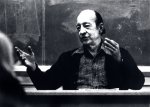
The influence of Williams as an historian rested not only on his publications, but also on his contribution as a teacher. Toward the end of the fifties, he was called back to Wisconsin as a member of the faculty. There both his performance in the classroom and work with individual students set standards that were extraordinary even for this excellent institution. It was his intention not merely to guide dissertations. He wanted also to reach students who were not as yet committed to history, and, when he thought he had discovered the talent and inclination, to nudge them in that direction.
Several who were later to achieve a measure of fame in their own right were "dragooned" into the profession in this way - to their own good fortune and that of American historiography. One of these, Walter LaFeber of Cornell, formerly a teaching assistant under Williams, was later to comment on the experience. "To sit in his class and listen to his lectures - that brought the instant realization of just what a college teacher is there for. Williams's method was to look at the whole history from the outside, take it apart, and then put it back together again from a completely new viewpoint." To be sure, quite often several "rather orthodox" undergraduates or a doctoral candidate might leave the lecture hall shaking their heads, but "even they weren't the same as they'd been before." Put briefly, Williams had the extraordinary ability to stimulate - indeed, to provoke - students to do their own independent thinking."

William Appleman Williams in lecture, ca. 1980s.
Image courtesy of the Oregon State University Daily Barometer.
He achieved this by the use of a very simple method: by confronting students with their own code of values. Good American middle-class families are in the habit of sharing their high standards by hanging a framed maxim just above the mantel. One frequently seen reads "Great Spirit, grant that I may not criticize my neighbor until I have walked a mile in his moccasins."
Naturally, "neighbor" does not refer to all, without distinction. Possible enemies of America are not necessarily foreseen as objects of sympathetic empathy. But it was exactly at this point that Williams employed his instructional strategy: for he wished to include, as people with their own legitimate problems, desires, and fundamental human dignity, exactly those who up to this point in America's postwar culture had been considered to be enemies. To be able to see an historical phenomenon "from the outside," as LaFeber had put it, meant nothing more than to step out of one's own shoes, those of one's own political culture, and to put on the moccasins OF THE OTHERS, bringing their perspective on the course of events into the historical discourse. And that was to pertain whether these others were minorities struggling in their own land for their civil rights, or national freedom movements in the "Third World," or even America's great global-strategic opponent.
Table of Contents
- On Academic Discourse and the Search for Truth
- Father of the Revisionist School
- The Open Door at Home
- A World Power Against its Will
- Transferring the Frontier Overseas
- An Unheard-Of Provocation
- From Corpus Christi to Madison
- Williams the Teacher
- Unexpected Icons
- Into the Mainstream, Briefly
- A Farewell Song

